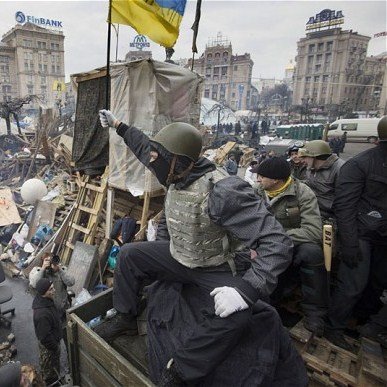As the situation in Ukraine’s eastern regions deteriorates, with more and more administration buildings in eastern cities and towns being occupied by separatist activists, it is worth remembering some parallel events that took place in late January. In the immediate aftermath of the passage of a set of repressive anti-protest laws by the Viktor Yanukovych government, anti-Yanukovych activists took over local administration buildings in a host of western and some central Ukrainian regions. The map below, posted on Facebook by Sergii Gorbachov, shows the extent of these protests as of Jan. 25. Regions with occupied administrative buildings are marked in blue and yellow, while regions where seizures were attempted but had been unsuccessful are marked in red. The southeast is largely quiet.
[[{“type”:”media”,”view_mode”:”media_large”,”fid”:”2293″,”attributes”:{“alt”:””,”class”:”media-image”,”height”:”320″,”typeof”:”foaf:Image”,”width”:”480″}}]]
It’s worth comparing this map to a map produced on Wednesday, based on information provided by the Ukrainian Information Resistance group. This map shows the regions where separatists have seized administrative buildings or have held rallies against the current Ukrainian government. The map also shows the Information Resistance group’s assessment of threats to security in Ukraine’s regions. The mirror image nature of the two maps is immediately apparent.
[[{“type”:”media”,”view_mode”:”media_large”,”fid”:”2294″,”attributes”:{“alt”:””,”class”:”media-image”,”height”:”326″,”typeof”:”foaf:Image”,”width”:”480″}}]]
The occupations of administration buildings that have taken place in recent weeks in eastern Ukraine are in part a reflection of tactics pioneered in Ukraine by pro-Maidan activists. These tactics have been changed to fit the very different circumstances in the east, where the separatist protesters do not have the overwhelming majority support of the population that the Maidan protesters did in western Ukraine in January. Instead, they have the covert support of Russian security services, which have almost certainly provided critical assistance with coordination and planning of the assaults on government buildings. There has also been a great deal more violence, with the number of casualties in the east growing weekly, whereas protesters in the west were far more restrained.
But there are certain parallels. In both cases, protesters have looted weapons from local armories. They have both used control of regional administrations to demonstrate the weakness of the central authorities and to push their opponents to make concessions that they were then reluctant to accept (instead seeking their opponents’ capitulation). And the adoption of tactics that were first used by Maidan protesters blunts the claims of illegitimacy made by the Ukrainian government, at least in the eyes of a sizeable percentage of the population in eastern Ukraine.
The end result remains entirely unclear. The Ukrainian government Wednesday admitted that it no longer controls Donetsk and Luhansk Oblasts. There is widespread fear that the separatists will use the May holidays to try to spread their activities to Kharkiv and possibly to southern Ukraine as well. They have the support of part of the population in the east and of the Russian government. Both were necessary to launch the operations, but at this point the occupations may be self-sustaining, with little further help from Russia needed.











